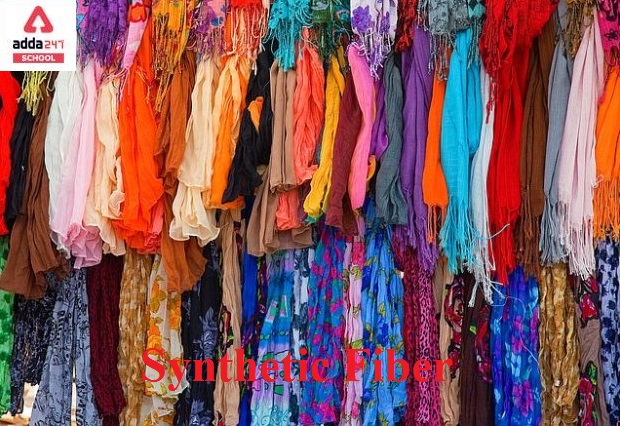Name some Synthetic Fibres in English
What is Synthetic fibre? the answer is available here. Synthetic fibres, as opposed to natural fibres that are generated directly from living organisms, are fibres created by humans by chemical synthesis.
They’re the result of years of research by experts to improve on natural fibres, obtained from animals and plants. Synthetic fibres are made by extruding fibre-forming ingredients via spinnerets and generating a ‘different’ fibre in the process.
Polymerization, which includes joining monomers to form a long chain or polymer, is used to generate synthetic fibres. Polymer is derived from the Greek prefix “poly,” which means “many,” and the suffix “mer,” which means “single unit.”
Also Read About Nylon fibers
What is Synthetic fibre?- In Hindi
सिंथेटिक फाइबर, प्राकृतिक फाइबर के विपरीत, रासायनिक संश्लेषण द्वारा मनुष्यों द्वारा बनाए गए फाइबर हैं। वे प्राकृतिक तंतुओं में सुधार के लिए विशेषज्ञों द्वारा वर्षों के शोध का परिणाम हैं। सिंथेटिक फाइबर स्पिनरेट्स के माध्यम से फाइबर बनाने वाली सामग्री को बाहर निकालकर और प्रक्रिया में एक ‘अलग’ फाइबर उत्पन्न करके बनाए जाते हैं। पॉलिमराइजेशन, जिसमें एक लंबी श्रृंखला या बहुलक बनाने के लिए मोनोमर्स को शामिल करना शामिल है, का उपयोग सिंथेटिक फाइबर उत्पन्न करने के लिए किया जाता है। पॉलिमर ग्रीक उपसर्ग “पॉली” से लिया गया है, जिसका अर्थ है “कई,” और प्रत्यय “मेर”, जिसका अर्थ है “एकल इकाई।”
Read About DNA
What are the advantages of Synthetic Fibre?
The glass was the first entirely synthetic fibre. Joseph Swan produced one of the first artificial fibres, which we now refer to as semisynthetic. His fibre was derived from a cellulose liquid created by chemically altering tree bark fibre. The synthetic fibre created through this process was chemically comparable to the carbon filament Swan had developed for his incandescent light bulb in terms of prospective applications, but Swan quickly understood the fibre’s potential to revolutionise textile manufacture.
Hilaire de Chardonnet, a French engineer and manufacturer, took the next step by inventing the first artificial silk, which he dubbed “Chardonnet silk.” In the late 1870s, Chardonnet was collaborating with Louis Pasteur on a cure for the French silkworm epidemic. Chardonnet discovered nitrocellulose as a viable replacement for actual silk after failing to clean up a spill in the darkroom. Chardonnet saw the importance of such a discovery and began developing his new product. However, the material used by Chardonnet was exceedingly combustible, thus it was eventually replaced with a more stable material.
In 1894, English scientist Charles Frederick Cross and his partners Edward John Bevan and Clayton Beadle devised the first successful technique of synthetic fibre. The fibre was given the term “viscose” by the researchers. Courtaulds, a business based in the United Kingdom, manufactured the first commercial viscose rayon in 1905. Later, the term “rayon” was coined to replace “viscose,” the viscous organic liquid used in both rayon and cellophane manufacturing.
In the 1930s, Wallace Carothers, an American researcher at the chemical business DuPont, produced nylon, the first synthetic fabric in the “completely synthetic” sense of the term. It was quickly used as a silk substitute in the United States.
The International General Electric business invented the first polyester fibre in Britain in 1928. It was also created in 1941 by British scientists John Rex Whinfield and James Tennant Dickson of the Calico Printers’ Association. They developed and patented Terylene, popularly known as Dacron, one of the earliest polyester fibres that were equivalent to or better than nylon in hardness and tenacity.
| CBSE Full Form | ICSE Full Form |
| CEO Full Form | SOP Full Form |
| AM PM Full Form | ACP Full Form |
FAQs on Name some Synthetic Fibres
What is the definition of synthetic fibre?
Synthetic fibres, are not generated directly from living organisms, instead these are fibres created by humans by chemical synthesis.
Name the first fully-synthetic fibre?
Nylon is the first ever fibre that is fully synthetic.
What are some of the drawbacks of synthetic fibre?
- Synthetic fabrics need extra care when ironing because they are prone to melting.
- The majority of these fibres only absorb a small amount of water. As a result, they stick to the body when you sweat on a hot summer day.
- Synthetic fibres have a high risk of catching fire.
- These fibres do not decompose.
Name the most common synthetic fibre.
Polyester is the most common synthetic fibre.
Which natural fibre is the strongest?
Silk is the strongest natural fibre.









 UP NEET Counselling 2025 Round 5 Merit L...
UP NEET Counselling 2025 Round 5 Merit L...
 RBSE Class 10 Model Paper 2026 Out, Down...
RBSE Class 10 Model Paper 2026 Out, Down...
 RBSE Class 12 Model Paper 2026 for Arts,...
RBSE Class 12 Model Paper 2026 for Arts,...














